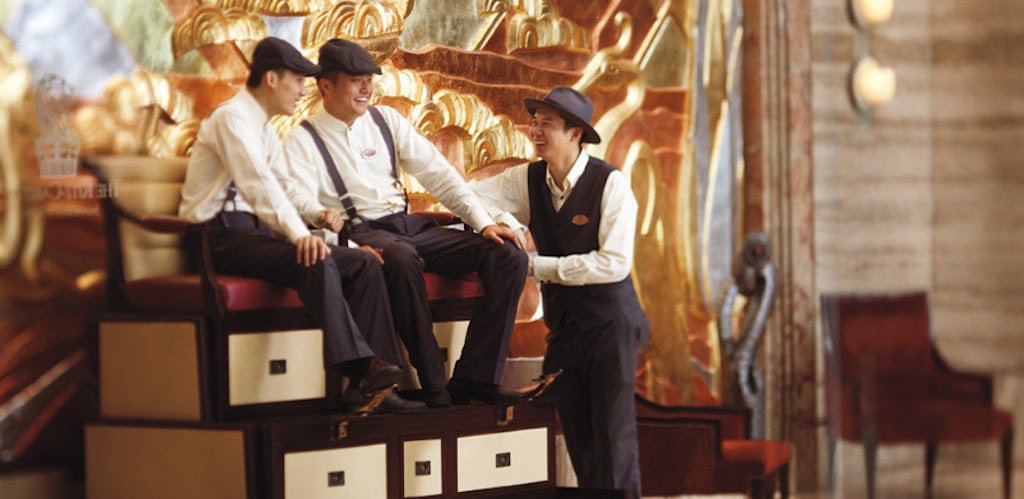Skift Take
The Ritz-Carlton Company is finding a sweet spot between modern design and traditional luxury for various age groups, but there's some work to be done on brand communications aligned with today's connected traveler.
- The Ritz-Carlton, Kyoto
- The Ritz-Carlton, Kyoto
- The Ritz-Carlton, Herzliya in Tel Aviv
- The Ritz-Carlton, Herzliya in Tel Aviv
- The Ritz-Carlton, Rancho Mirage
- Dorado, a Ritz-Carlton Reserve in Puerto Rico
- The Nile Ritz-Carlton, Cairo
- The Ritz-Carlton, Moscow
- Phulay Bay, a Ritz-Carlton Reserve, Thailand
- The Ritz-Carlton, Wolfsburg in Germany
- The Ritz-Carlton Shanghai, Pudong
- The Ritz-Carlton Shanghai, Pudong
The Ritz-Carlton Hotel Company is in aggressive expansion mode, especially internationally, riding the wave of increasing demand for top-tier luxury travel from both domestic and emerging foreign markets. Of late, there’s been a decided shift toward a more youthful and contemporary design energy with hotels like The Ritz-Carlton, Herzliya outside Tel Aviv, which opened in December, and The Ritz-Carlton, Kyoto unveiled last week.
The Ritz-Carlton, Rancho Mirage is up next in Palm Springs, California, followed by Bali, Los Cabos, Cairo, Macau and Abu Dhabi, among others, with the goal of 100 properties by 2016.
Like all legacy hotel groups, Ritz-Carlton is shifting its development and operations to meet the needs of a rapidly evolving travel consumer in today’s quixotic hospitality industry. Unlike most established brands however, Ritz-Carlton’s very identity is rooted in tradition and classical notions of service and propriety. Meaning, the luxury brand is navigating between younger and older client psychographics to cultivate business with the former while respecting the loyalty of the latter and protecting the legacy of the brand.
The challenges begin with Ritz-Carlton’s longstanding motto: “Ladies and gentlemen serving ladies and gentlemen.” Younger travelers view that language as somewhat nostalgic, even archaic, but the sentiment resonates deeply with Boomers.
“We get asked about our motto a good bit, but regardless of the words used, the meaning behind it is a core value for us,” says Lisa Holladay, VP of brand management for Ritz-Carlton. “It’s based on this mutuality of respect for the ladies and gentlemen who have decided to go into the hospitality business, and how they take care of the ladies and gentleman who choose to stay with us. At the end of the day, it’s about the genuine care and comfort of our guests, and I can’t imagine how that would ever go out of date.”
It’s also presumptive to believe that younger wealthy travelers don’t appreciate decorum and civility to some degree. So much of our preoccupation these days in tourism focuses on “the next generation” of everything, from hybrid hostels to wearable tech. It sometimes seems like we’ve relegated traditional luxury and social mores, and the respect for them, to a diminishing class of My Fair Ladies wearing floppy hats during afternoon tea at Ascot.
The data doesn’t support that. For the last four consecutive years, Ritz-Carlton won top spot in the luxury category in the J.D. Power North America Hotel Guest Satisfaction survey. Luxury, and by that we mean expensive luxury versus so-called “experiential luxury,” is still very much in demand domestically. After six years of downward pressure on luxury travel bookings, the 2013 Survey of Affluence & Wealth in America stated that the top 10% of Americans planned to increase spending on luxury hotels by 17%.
To attract those discriminating buyers with so much discretionary spending, Ritz-Carlton is constantly evaluating and updating what is already considered the most intense and nuanced staff training in the industry. It’s designed to enhance “The Ritz-Carlton Mystique,” defined as a sort of sixth sense about engaged, anticipatory service. Moreover, the philosophy of mutual respect behind the staff training has resulted in the lowest employee turnover rate in the hotel sector.
Looking ahead, Holladay asserts that Ritz-Carlton is adapting to modern trends in terms of design and programming, while remaining grounded in Ritz-Carlton culture.
“Any brand that has the type of heritage we have is lucky to have it, so I think we’re starting in a great place,” she says. “We know that across generations, there’s a respect for brands with that heritage, and an appreciation of things like quality craftsmanship. At the same time, we have to be able to evolve, and to make changes when they’re appropriate.”
An Evolution of Design Narratives
The biggest change over the last decade has been an all-encompassing shift in hotel design. It began in 2002 with the opening of The Ritz-Carlton, Bachelor Gulch in Colorado, constructed in “Parkitecture” style utilizing massive hewn logs inspired by the Old Faithful Inn in Yellowstone. Previous to that, Ritz-Carlton was known for its beige-y, British Colonial-themed boxes heralding Kipling, Conrad and pre-Victorian English monarchy.
Also responsible for inspiring more authentic hotel designs over the last decade, respective to their individual destinations, Ritz-Carlton’s expansion across Asia, Europe and the Middle East has influenced more diverse aspirations in the design narratives.
“I think the design question is a really fascinating one, especially for our brand with a lot of heritage,” says Holladay. “When we go to look at a renovation cycle or a conversion cycle, we ask: What do we need to think about with design to appeal to the Millennial generation, or the next generation traveler? So we’ve embarked on a design strategy project this year, and we’ve looked at it not just from a generational perspective, but from a global perspective.”
Holladay adds, “We did research in Hong Kong, Shanghai, L.A., New York, Abu Dhabi and Dubai, across generations and geographical areas, and there were actually a lot of similarities between what consumers want from the design of the physical project.”
She says the two most popular findings across the board include high demand for more attuned regional design, and bringing the outdoors in for a deeper connection to nature.
“Both of those will have a lot of impact on the design of our hotels moving forward,” explains Holladay.
You’re seeing those trends manifested already in the exclusive, eco-luxury Ritz-Carlton Reserve projects. These are intimate sanctuaries in pristine, remote locales with a strong sense of story and romance revolving around the preservation of the local culture and environment.
The year-old, 100-suite Dorado Beach, a Ritz-Carlton Reserve in Dorado, Puerto Rico is a classic example of mid-century tropical modernism, originally built seamlessly into the landscape by wealthy environmentalist Laurance Rockefeller. The 54-suite Phulay Bay, a Ritz-Carlton Reserve in Thailand is located in the emerging region around Krabi.
The Reserve sub-brand was put on hold during the recession but the development pipeline is back on track with new Reserves scheduled to open soon in Bali and Cabo. Those will be followed by Turks & Caicos, Panama, Oman and Morocco.
A Need for Better Brand Storytelling
Why any hotel group with more than a handful of hotels doesn’t have a dedicated, full-time editorial content team in place in our 24/7 digital media landscape is a constant source of confusion for those of us covering the hospitality industry.
Back in the day, as it were, during the beginning of the web, there was always a small thrill when clicking over to ritzcarlton.com because no brand at the time invested as much in high-end photography. That was a long time ago. Today, Pinterest and other platforms have turned jaw-dropping travel imagery into a commodity. Consumers want the context behind that imagery.
For people interested in learning more about the individual stories at each Ritz-Carlton, and equally important, the destinations they inhabit, they’re presently at a bit of a loss. The Reserve product, for example, is (most likely) rich with endless stories about its unique programming and community integration, but there’s really nowhere to engage with those stories.
There is “The Ritz-Carlton Story” link at the top left of the homepage directing users to the Summer 2011 issue of The Ritz-Carlton Magazine. The dropdown menu also includes “Memories by The Ritz-Carlton” and “Stories That Stay With You,” which both link to the same mosaic page of bite-size epilogues contributed by hotel staff chronicling cute moments revolving around guest interactions.
Those “Memories” stories are also featured on the app, but they come across as a bit of a tease. Ritz-Carlton could, and should, blow this type of storytelling into a full-bore microsite with indepth destination information, consumer reviews, and crowdsourced comments and photos to attract younger guests craving authentic, topical content.
Holladay says Ritz-Carlton does have a digital initiative on Foursquare called “World Concierge Tips.” The Ritz-Carlton Foursquare page has a list of destination-specific concierge recommendations that change as you move around the Foursquare map.
“Our digital platform will be expanded in 2014, we just haven’t announced quite what that will be, but it’s very exciting,” says Holladay. “It will be based around ‘Wow’ stories, from small moments about someone stuck at a hotel, and what the hotel did to go above and beyond, to someone getting engaged at a hotel.”
Ritz-Carlton has the opportunity to shift its brand resonance significantly among younger generations of “ladies and gentlemen” with this new platform. The company’s vaunted heritage and glamorous destinations offer a lot of cool content possibilities, but the distribution of that content is equally important in this era.
Greg Oates covers hospitality and tourism trends. He’s toured over 1,000 hotels in 50+ countries.
Have a confidential tip for Skift? Get in touch
Tags: millennials, ritz-carlton












